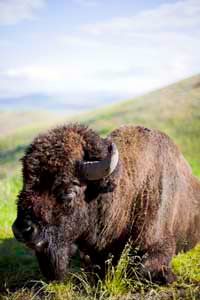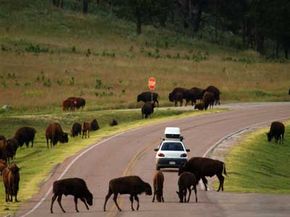Key Takeaways
- The bison population in North America faced near-extinction in the 19th century due to overhunting, habitat destruction and government policies against Native American tribes.
- Conservation efforts, including protected areas, breeding programs and collaboration with Native American tribes, have significantly contributed to the recovery of bison populations.
- Today, bison numbers have increased due to these efforts, as well as private ranching and the commercial bison meat market.
Before the West was won, tens of millions of bison dominated the American landscape. Their pre-colonial range spanned almost the entire United States, with a concentration in the Great Plains, extending from Canada to northern Mexico. Bison -- commonly known as buffalo -- congregated in thundering herds, grazing on thousands of acres of virgin grasslands. Vegetation on the Plains was well suited to the bison diet because the grasses' roots are packed with vitamins and minerals to allow for swift regrowth [source: Savage]. During that time, Native American tribes across the Great Plains hunted bison, using the enormous bovines for food, clothing and shelter materials, tools and more [source: Allen].
Two bison species are native to North America: plains bison and wood bison. Weighing nearly a ton, bison are the largest land mammals in the United States [source: Sample]. Despite their size, bison can sprint at speeds up to 35 mph (56 kph) [source: National Park Service]. Although they only feed on grass, bison are a keystone species in the Plains, meaning their influence in the environment affects the well-being of many other species.
Advertisement
But in the 1700s, the horse's arrival in the West sparked the bison's demise in North America. Riding horses and the invention of the .50-caliber rifle transformed buffalo hunting from low casualty affairs to all-out massacres [source: Cloud]. At the beginning of the 19th century, the market for buffalo hide boomed in the United States and Canada as well as Europe. The combination of efficient hunting methods and a growing demand set the stage for the period dating from roughly 1820 to 1880, known as "the Great Slaughter."
Hunters slaughtered bison across the Great Plains by the thousands, slicing the population from 30 million to just over 1,000 by 1890 [source: American Bison Society]. Because they became so scarce and bison extinction seemed imminent, Theodore Roosevelt, William Hornaday and other formed the American Bison Society in 1905 to ensure the species' survival. By that point, the Bronx Zoo and Yellowstone National Park had also established bison preserves, and in 1908, the federal government created the National Bison Range in Montana. Ironically, these conservation efforts wouldn't become the driving force behind the bison population comeback.
Advertisement


